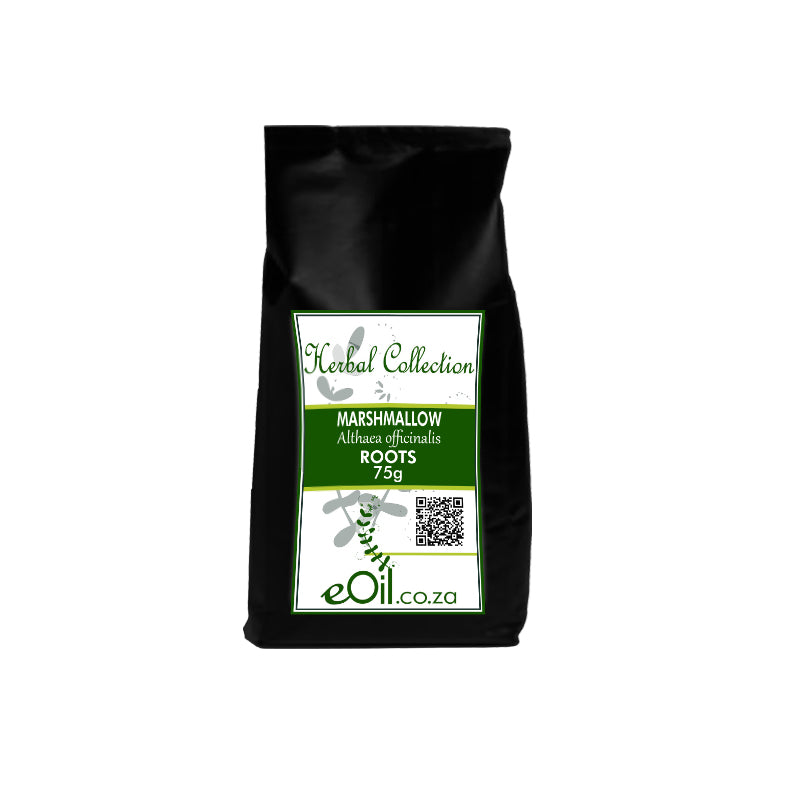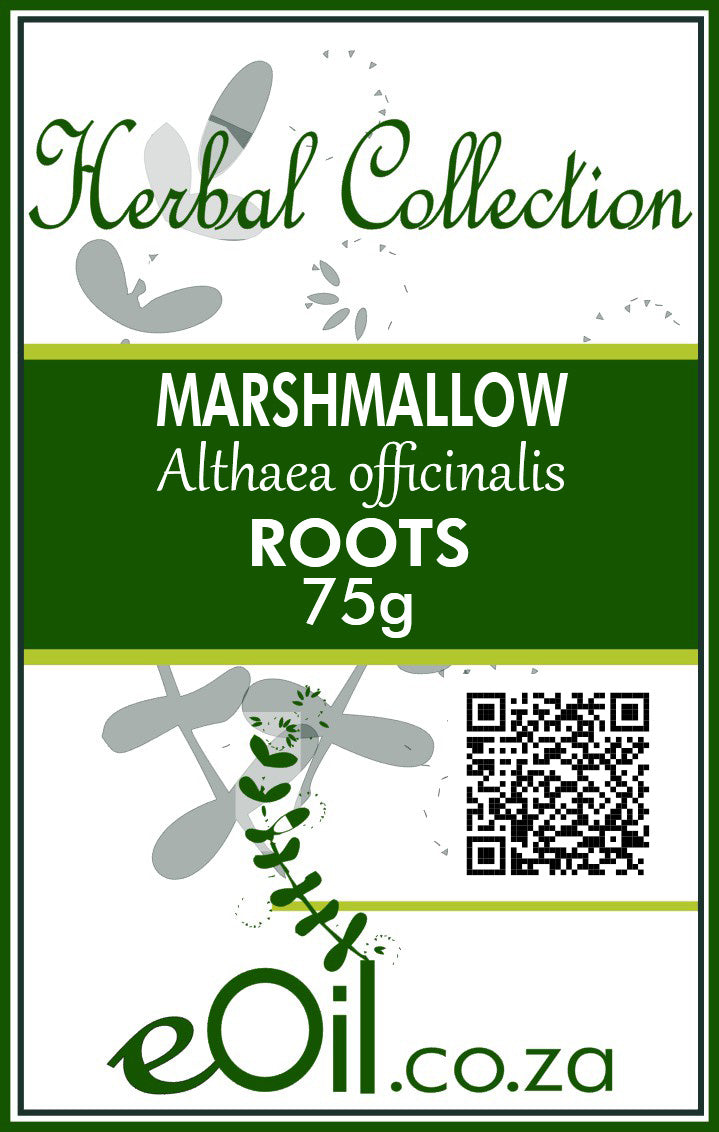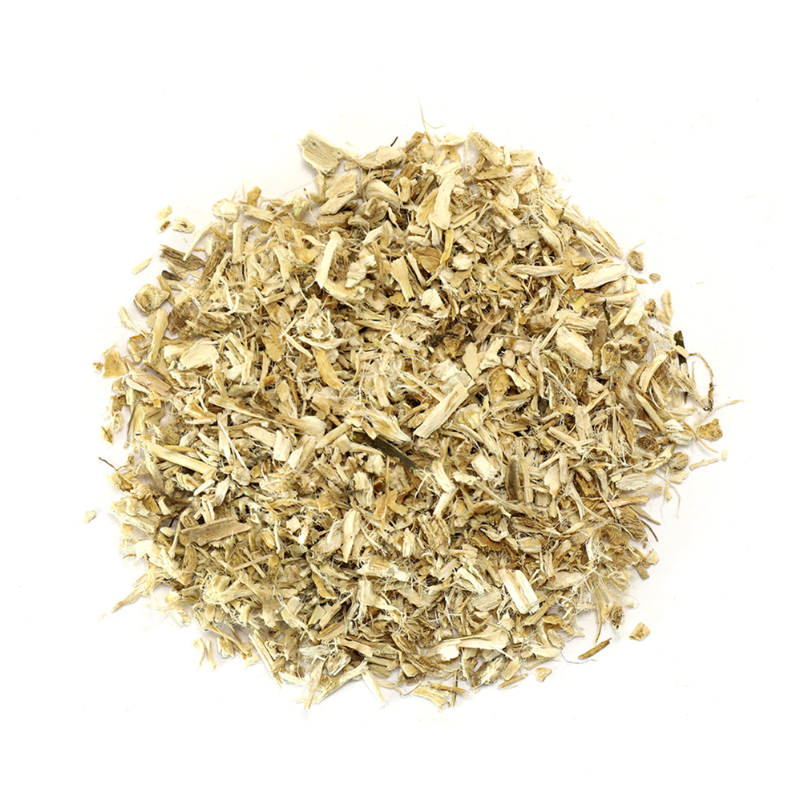Marshmallow root - Herbal Collection
Marshmallow root - Herbal Collection - 75 g is backordered and will ship as soon as it is back in stock.
Description
Description
Marshmallow root 75 g - Fine cut - Herbal Collection
Althaea officinalis - unpeeled
Dried marshmallow root, derived from the Althaea officinalis plant, has been traditionally used for its soothing and mucilage-rich properties.
It's known for its potential to support digestive health, soothe throat irritation, and promote a healthy respiratory system.
Marshmallow root is often used in teas, lozenges, or extracts to provide a gentle and comforting addition to wellness routines.
TRADITIONALLY USED FOR
A traditional herb with soothing and calming properties that are most used for digestive and respiratory problems
Tea made from the leaves or flowers is used to help with runny nose and colds in infants and toddlers, dry and irritating coughs, swollen nose and throat, and ear pain.
Marjoram tea is also may also help when used for various digestion problems including poor appetite, liver disease, gallstones, intestinal gas, and stomach cramps
Always check with your herbal practitioner before using herbal products
Caution for pregnancy, nursing or on medications.
INFORMATION
Source : http://www.wikiphyto.org/wiki/Guimauve
Reference on http://www.wikiphyto.org
Translation in English by Google Translate (go to the page of the source linked | on Chrome cellphones go on the 3 dots on the top right and select translate in your preferred language | on laptop right click your mouse and select option translate when hoovering on the page
plant name
Marshmallow, marshmallow (English)
International Latin denomination
botanical family
Malvaceae
Description and habitat
- Tall perennial herb (60 - 120 cm), with lobed and toothed leaves
- Corolla with 5 pinkish white petals
- Spontaneous throughout Europe, especially the marshes and coasts of the Atlantic coast
- Conical taproot in white color
History and tradition
- Théophraste already advised her in coughing
- It is an ingredient for confectionery
- Belongs to the pectoral species: White Bouillon flowers , Poppy , Marshmallow , Mallow , Cat's Foot , Coltsfoot , Violet
Parts used
- root, leaf, flower
Dosage forms available
- Underground Part Tincture
- Flower and root herbal teas
- Fluid extract
Usual dosages
Composition
Main components of the plant
- Leaf: mucilages (6 to 9%): arabinogalactans and galacturonorhamnanes ( rhamnogalacturonan )
- Flavonoids : 8-hydroxyluteolin-8-gentibioside
- Root :
- Polysaccharides ( mucilages , 5-20%): arabinans , glucans , arabinogalactans (branched structure of D-galactose, L-rhamnose, D-glucuronic acid and D-galacturonic acid )
- Flavonoids , isoscutellarein derivatives
- Starch, phenolic acids, amino acids
- Coumarins ( scopoletol = scopoletin ) [1]
Main components of buds or young shoots
Main components of essential oil
Properties
Plant properties
- The root is emollient ( polysaccharides ) [2]
- The root is immune-stimulating ( polysaccharides ) [3]
- The root is antitussive (demonstrated effect of mucilages , especially rhamnogalacturonan ) [4] , [5] , [6] , but not expectorant
- The root is anti-inflammatory [7] , [8] and antioxidant [9]
- Antibacterial [10]
- Reduces gastric acidity
- Mild laxative
- Hypoglycemic
- Angiotensin converting enzyme (ACE) inhibitor [11]
- The flower is antioxidant [12]
Bud properties
Properties of essential oil
Directions
Indications of the whole plant (phytotherapy)
- Marshmallow Root Stick in Teething
- periodontal diseases
- Irritating dry cough, asthma, bronchial hypersecretion
- All inflammatory disorders of the digestive tract: gastritis, ileitis, colitis, diverticulitis, proctitis
- Cystitis
- Skin inflammation, boils and abscesses in local application of the flower infusion
- Bleaching agent, inhibition of melanocyte activation [13]
Indications of the bud (gemmotherapy)
Specific indications of essential oil (aromatherapy)
Known or suspected mode of action
- The mucilages dissolve more or less and swell on contact with water to form colloidal solutions improving the glide of secretions
Usual formulations
Regulations
- French Pharmacopoeia list A (leaf, flower, root)
Possible side effects and precautions for use
Bibliographic references
- Aller↑ Gudej J. Flavonoids, Phenolic Acids and Coumarins from the Roots of Althaea officinalis. PlantaMed. 1991 Jun;57(3):284-5. PMID 17226162
- Aller↑ Peter Capek, Rudolf Toman, Alžbeta Kardošová, Jozef Rosík. Polysaccharides from the roots of the marsh mallow (Althaea officinalis L.): Structure of an arabinan. Carbohydrate Research, Volume 117, 16 June 1983, Pages 133–140
- Aller↑ SM Ali Shah, Naveed Akhtar, M. Akram, Pervaiz Akhtar Shah, Tariq Saeed, Khalil Ahmed, HM Asif. Pharmacological activity of Althaea officinalis L. Journal of Medicinal Plants Research Vol. 5(24), p. 5662-5666, October 30, 2011 [1]
- Aller↑ Gabriela Nosáľvá, Anna Strapková, Alžbeta Kardošová, Peter Capek. Antitussive Activity of a Rhamnogalacturonan Isolated from the Roots of Althaea Officinalis L., Var. Robusta. Journal of Carbohydrate Chemistry, Volume 12, Issue 4-5, 1993 [2]
- Aller↑ Sutovská M, Nosálová G, Sutovský J, Franová S, Prizenznáková L, Capek P. Possible mechanisms of dose-dependent cough suppressive effect of Althaea officinalis rhamnogalacturonan in guinea pigs test system. Int J Biol Macromol. 2009 Jul 1;45(1):27-32. PMID 19447256
- Aller↑ Sutovska M, Nosalova G, Franova S, Kardosova A. The antitussive activity of polysaccharides from Althaea officinalis l., var. Robusta, Arctium lappa L., var. Herkules, and Prunus persica L., Batsch. Bratisl Lek Listy. 2007;108(2):93-9. PMID 17685009
- Aller↑ A.E. Al-Snafi. The pharmaceutical importance of Althaea officinalis and Althaea rosea: a review. Int J PharmTech Res 5(3), 1378-1385
- Aller↑ Sutowska M et al. Antitussive activity of Althaea officinalis polysaccharide rhamnogalacturonan and its change in guinea pigs with ovalbumin-induced airways inflammation. Bratisl Lek Listy, 2011, 112 12 [3]
- Aller↑ Mahfuz Elmastas, Lokman Ozturk, Isa Gokce, Ramazan Erenler, Hassan Y. Aboul‐Enein. Determination of Antioxidant Activity of Marshmallow Flower (Althaea officinalis L.). Analytical Letters, Volume 37, Issue 9, 2004
- Aller↑ Suzan Ozturk, Sezai Ercisli. Antibacterial Activity of Aqueous and Methanol Extracts of Althaea officinalis. and Althaea cannabina. from Turkey. Pharmaceutical Biology 2007 45:3, 235-240
- Aller↑ Rouhi Hamid, Ganji Forouzan. Effect of Althaea Officinalis on Cough Associated with ACE Inhibitors. Pakistan Journal of Nutrition 01/2007 [4]
- Aller↑ Mahfuz Elmastas, Lokman Ozturk, Isa Gokce, Ramazan Erenler, Hassan Y. Aboul-Enein. Determination of Antioxidant Activity of Marshmallow Flower (Althaea officinalis L.). Analytical Letters, Volume 37, Issue 9, 2004, pages 1859-1869 DOI:10.1081/AL-120039431
- Aller↑ Akemi Kobayashi, Akira Hachiya, Atsushi Ohuchi, Takashi Kitahara, Yoshinori Takema. Inhibitory Mechanism of an Extract of Althaea officinalis L. on Endothelin-1-Induced Melanocyte Activation. Biological and Pharmaceutical Bulletin, Vol. 25 (2002), No. 2229
- Wichtl Max, Anton Robert. Therapeutic plants: Tradition, officinal practice, science and therapy. Ed. Tec & Doc. Cachan. 1999. p. 23
- Rani S, Khan SA, Ali M. Phytochemical investigation of the seeds of Althea officinalis L. Nat Prod Res. 2010 Sep;24(14):1358-64. doi: 10.1080/14786411003650777. PMID 20803381
CAUTION
Store in a cool, dry place, away from light. Keep tightly closed, away from the reach of Children and pets.
Do not exceed the daily dose.
This product is not intended to prevent or cure any form of illness or disease.
If you are pregnant or nursing ; If you have a medical condition or are in the course of medical treatment ; If you are programmed for theater/operation in the near future, please consult your healthcare practitioner before using this product.
This product cannot replace a varied and balanced diet and a healthy lifestyle.
This product has not been evaluated by the SAHPRA for its quality, safety or intended use.
For More Information please check our General Safety Herbal products Page

Marshmallow root - Herbal Collection - 75 g is backordered and will ship as soon as it is back in stock.





